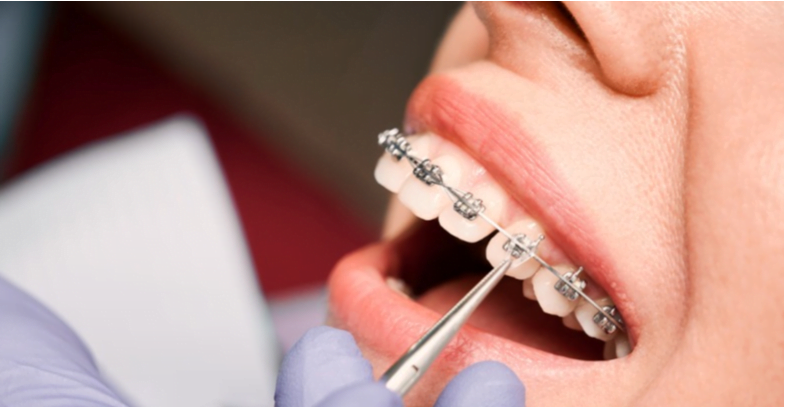Embarking on the journey of orthodontic treatment often entails the embrace of constrictive braces, an essential tool in the quest for a harmonious smile. These meticulously crafted devices exert controlled pressure on teeth, guiding them towards alignment and optimal positioning. Understanding the dynamics of constrictive braces is paramount for individuals traversing this transformative path. Learn more about adult orthodontics.
Embarking on the odyssey of dental care often entails the embrace of taut braces, an indispensable apparatus in the pursuit of a symmetrical smile. These intricately fashioned contrivances exert meticulous pressure on teeth, guiding them towards symmetry and optimal positioning. Understanding the dynamics of taut braces is paramount for individuals traversing this transformative journey.
Taut braces represent more than just a means to straighten teeth; they symbolize a commitment to self-improvement and the pursuit of dental excellence. Each adjustment signifies progress, inching closer to the coveted goal of a radiant smile. As dentists meticulously fine-tune the tension of wires and brackets, they sculpt not only the physical landscape of teeth but also the confidence and self-assurance of their patients.
CONTACT DETAILS
- Amazing Smiles Orthodontics: Forest Hills 100-25 Queens Boulevard Forest Hills, NY 11375
- Phone: (718) 275-3200
- Email: amazingsmilesnyc@gmail.com
How Do Orthodontists Tighten Braces
The process of tightening braces is a pivotal aspect of orthodontic care, orchestrated by skilled orthodontists with precision and expertise. Employing specialized tools and techniques, orthodontists meticulously adjust the tension of the braces, incrementally nudging teeth towards their desired orientation. This process involves the strategic manipulation of wires and brackets, delicately fine-tuning the forces applied to each tooth. While the specifics may vary depending on individual treatment plans, the overarching goal remains consistent – to facilitate progressive movement and achieve optimal alignment.
Tightening braces is a pivotal aspect of dental care, orchestrated by skilled professionals with precision and expertise. Employing specialized tools and techniques, dental professionals meticulously adjust the tension of the braces, incrementally nudging teeth towards their desired symmetry. This process involves the strategic manipulation of wires and brackets, delicately fine-tuning the forces applied to each tooth. While the specifics may vary depending on individual plans, the overarching goal remains consistent – to facilitate progressive movement and achieve optimal symmetry.

Does It Hurt To Tighten Braces
The prospect of braces tightening may evoke apprehension, particularly regarding discomfort or pain. However, sensations experienced during the tightening process can vary widely among individuals. Some may report minimal discomfort, akin to a fleeting sensation of pressure, while others may perceive a more pronounced sensation. Factors such as individual pain tolerance, the extent of adjustment required, and the condition of oral tissues can influence the perception of discomfort. Nonetheless, it’s essential to recognize that any discomfort experienced during braces tightening is typically temporary and transient. Orthodontists employ various strategies to mitigate discomfort, including the application of numbing agents or adjusting the pace of tightening to ensure optimal comfort for patients.
Brace tightening may evoke apprehension, particularly regarding discomfort or pain. However, sensations experienced during the tightening process can vary widely among individuals. Some may report minimal discomfort, akin to a fleeting sensation of pressure, while others may perceive a more pronounced sensation. Factors such as individual pain tolerance, the extent of adjustment required, and the condition of oral tissues can influence the perception of discomfort. Nonetheless, it’s essential to recognize that any discomfort experienced during braces tightening is typically temporary and transient. Dental professionals employ various strategies to mitigate discomfort, including the application of numbing agents or adjusting the pace of tightening to implement optimal comfort for individuals.
What Helps Tight Braces
Navigating the realm of constrictive braces can be accompanied by challenges, but there are measures one can take to alleviate discomfort and support the effectiveness of treatment.
Maintaining a consistent oral hygiene regimen is paramount, as braces create additional surfaces where food particles and plaque can accumulate. Regular brushing and flossing, coupled with the use of specialized orthodontic cleaning aids, help prevent the buildup of debris and mitigate the risk of dental issues such as cavities and gum inflammation.
Furthermore, adhering to dietary guidelines recommended by orthodontists can contribute to the smooth progression of treatment. Avoiding hard, sticky, or excessively chewy foods reduces the risk of damaging braces components or impeding tooth movement. Opting for soft, braces-friendly alternatives ensures that braces remain intact and functional, facilitating optimal treatment outcomes.
A hygiene regimen is paramount, as braces create additional surfaces where food particles and plaque can accumulate. Regular brushing and flossing, coupled with the use of specialized dental cleaning aids, help prevent the buildup of debris and mitigate the risk of dental issues such as cavities and gum inflammation.
Recommend professionals can contribute to the smooth progression of care. Avoiding hard, sticky, or excessively chewy foods reduces the risk of damaging braces components or impeding tooth movement. Opting for soft, braces-friendly alternatives ensures that braces remain intact and functional, facilitating optimal care outcomes.
Engaging in open communication with your orthodontist is also instrumental in navigating the challenges associated with constrictive braces. Expressing any concerns or discomfort allows orthodontists to tailor treatment approaches to your unique needs, ensuring a collaborative and supportive orthodontic journey.
Pursuit of oral alignment and aesthetic enhancement. By understanding the mechanisms of braces tightening, acknowledging potential discomfort, and implementing supportive strategies, individuals can navigate the journey of orthodontic treatment with confidence and resilience, ultimately reaping the rewards of a radiant and confident smile.
